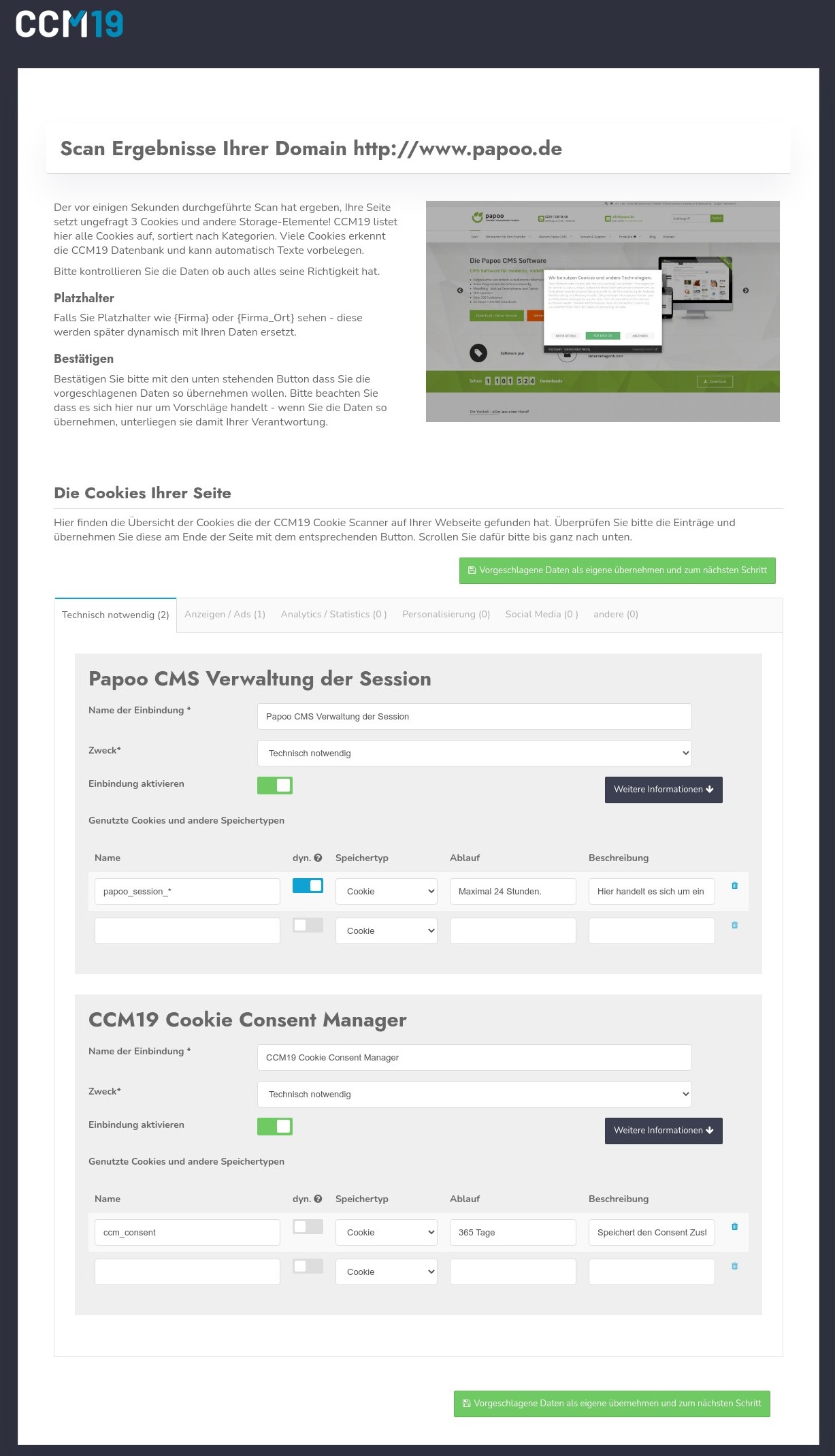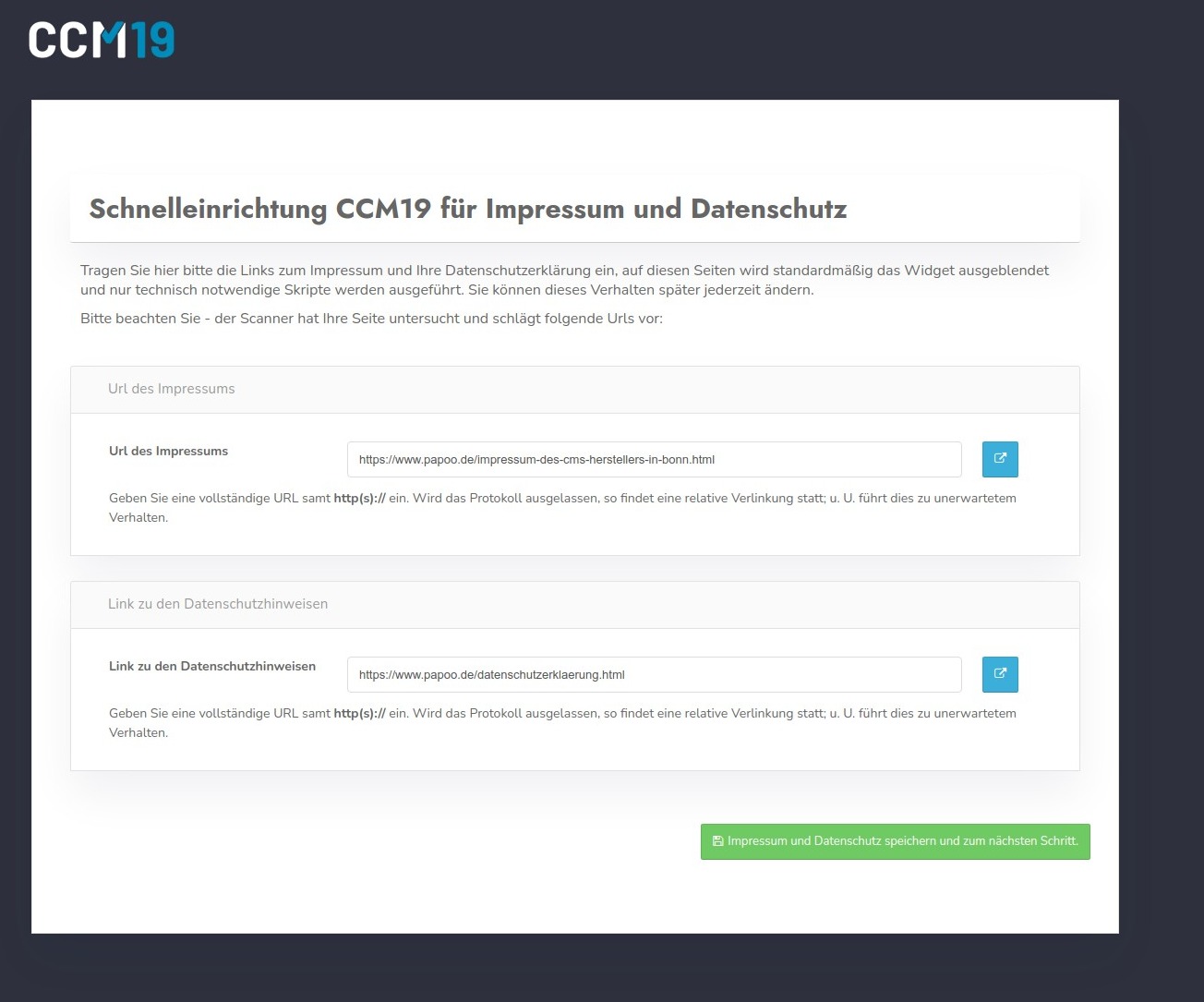Onboarding durchführen
Onboarding - Step 1
Directly after the first call in the administration, you will be guided through the so-called onboarding. In this process, the most important points of your site are queried, scanned and processed. You can make corrections at every step.
Everything that is created during onboarding can be adjusted and changed later in the administration.
If onboarding does not start automatically, you can simply click on the following link on the dashboard:
Enter the domain
After logging in for the first time, the following screen appears - where you can enter your domain and have it scanned for cookies and scripts. It is important that you confirm the security notice.
Of course you can also do everything manually, just click on the link "Skip setup - I do everything manually".
Onboarding - Step 2
In this step, the results of the automatic scan of your page are displayed. You can accept and adjust the data here. An entry is created for each provider or embed found.
The cookies and storage elements used are listed for each of these entries.
Evaluate scan results
You can add and adjust the legally required texts for each entry here.
Our database runs in the background and automatically assigns the cookies and storage elements found
Furthermore, a screenshot of the page is created for you to check that the correct page has actually been scanned.
The results are divided into the 5 standard categories to which scripts, cookies and storage elements are normally assigned.
- Technically necessary ( Essential)
- Ads
- Analytics / Statistics
- Personalization
- Social Media
- Miscellaneous
Behind each entry you can see how many entries were found in the respective category and could be sorted automatically.
Input fields are provided for all information that CCM19 considers necessary.
Name of the integration
The name of the integration - can be Google Analytics or Facebook Pixel, for example. You should use a meaningful name here.
Purpose
The categories mentioned above appear here. You can assign any entry to any category. Please note, however, that you must observe the legal framework conditions. Facebook Pixel, for example, is unlikely to be correctly categorized under technically necessary.
Activate
This activates the entry so that it can also be selected in the frontend
Automatic update
If the integration can be assigned to an integration in the database, this option can be activated. This means that the entry is also automatically updated in your CCM19 when it is updated in the CCM19 database.
The following points are only visible if you click on the "More information" button.
Block scripts that contain the following text
Here you can block scripts that are embedded in the source code of your page using CCM19. We show you an example here using the Google Analytics-script.
<!-- Global site tag (gtag.js) - Google Analytics -- >
<script async src="https://www.googletagmanager.com/gtag/js?id=UA-123456789-1"></script>
<script>
window.dataLayer = window.dataLayer || [];
function gtag(){dataLayer.push(arguments);}
gtag('js', new Date());
gtag('config', 'UA-123456789-2');
</script>
Then enter e.g. "googletagmanager.com" in the field - This will block any JavaScript on your site that contains this character (string) and the script will not be executed unless consent has been given.
In this way, you do not necessarily have to modify your site.
Block iframes that contain the following text
Just as with the scripts in the point above, iframes that contain a specific string can also be blocked For example, you could enter "youtube" here. All iframes containing this character (string) will then be blocked as long as no consent has been given.
Source code of the integration
Insert the source code of the snippet here. If you have not already integrated it via your website, you can integrate it here via CCM19. (We recommend the integration via CCM19)
Provider of the cookie
The provider - The company name of the provider offering the script must be entered here. In our case it would be Google Ireland Limited. You can also enter the full address of the company directly here.
Description of the cookie
Enter the purpose of the integration in the description. Why is it set? What does this integration do?
Data protection-Link for the cookie
The link to the provider's privacy policy belongs here. You can usually find this when you go to the provider's website.
What data is collected?
Exactly what data is collected? Just the IP? Or also click data, browser data, logins, behavior and much more? Find out exactly from the provider of the script and enter as precisely as possible what happens to the data. This is the only way to obtain informed consent from your visitors.
For what purpose is the data collected?
Why do you collect this data? What do you want to do with it? Conversion optimization? Improve the user experience? Or just implement a shopping cart function?
Legal basis
Here you define the legal basis on the basis of which you want to carry out this integration. In the case of tracking scripts, usually only "consent, Art. 6 para. 1 lit. a GDPR" - Consent of the visitor through an informed decision. So purely voluntary.
Place of processing
Where the data is processed. Here not only the address of your office applies, but also where is the server located? Please also take into account that you are currently not allowed to transfer data to unsafe third countries. Providers that export data to the USA are probably not legally possible at present (as of 29.09.2020).
List of cookies and storage elements
All cookies and storage elements set by the script are listed here. You can enter further elements manually later via the administrative interface, as the automatic scan cannot always find all data. e.g. the scanner cannot find any data if a logged-in status is required for this.
Name
The name in the browser - e.g. _ga for a Google Analytics cookie
dyn.
This determines whether it is a dynamic variable - e.g. _g* blocks all cookies that begin with _g, i.e. _ga, _gid etc.
Storage type
How the data is stored in your browser. (Cookie, local storage, session storage, IndexedDB, Web SQL, other)
Lifetime / Expires
When does the storage entry expire automatically.
Description
If cookies have different meanings, enter them here. In most cases, however, it is sufficient to enter the description that has already been entered above.
Accept data
Once you have checked all the data and made any necessary adjustments, click on the button below the form to transfer the data to the CCM19 administration - see screenshot.
Onboarding - Step 3
In step 3, enter the links to your legal notice and your privacy policy. You can change this data at any time later in the administration.
As the system knows the page and has scanned it in the previous step, links to the legal notice and privacy policy are usually entered automatically in the fields, as can be seen in the next screenshot.
Please adjust the data if necessary so that the correct links are entered. Then click on the green button to proceed to the next step.
Onboarding - Step 4
Here you define the placeholder texts for your page -. The most important are the following, which you can also see in the screenshot below:
-{COMPANY}-> Enter the name of your company here. -{Company_Privacy}-> Enter the link to your privacy policy here. -{Company_Location}-> Enter the location of your company with zip code and town here.
Once you have entered the data, click on the green button below.
You can of course add further placeholders at any time. Simply enter the new placeholder in the bottom field. If the last field is filled, a new field is automatically displayed below it.
Onboarding - Step 5
On the last page of the onboarding you will find the CCM19 embed code for your website. You do not need to remember it here - It is also always displayed in the administration dashboard. However, you can of course copy it directly and integrate it into your website.
By default, 3 codes are generated. Automatic language selection, German, English.\ You can generate additional codes for other languages by activating the corresponding language in the administrative interface. → Translations / Texts - CCM19 Cookie Consent Manager Documentation
Integration code
The binding code can look like this, for example.



.jpg)


.png)